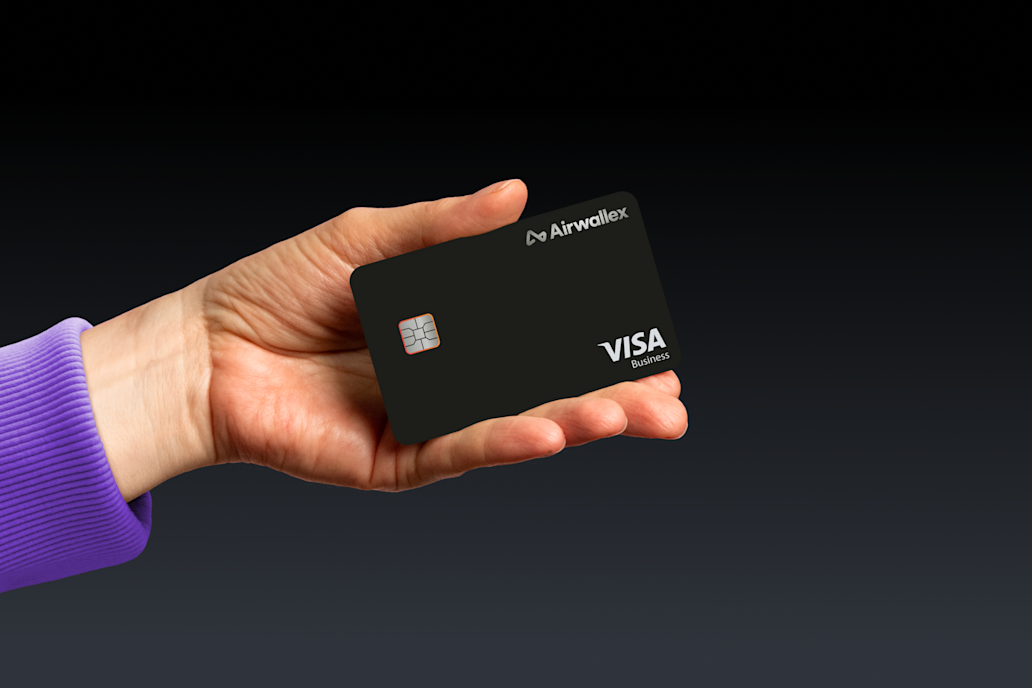Virtual card vs physical cards: Which comes out on top?

Airwallex Editorial Team

Key takeaways:
Virtual cards are digital-only cards that can be issued instantly, offer greater control and security, and are ideal for the demands of modern business spending.
Physical cards remain useful for in-person transactions, travel, and team members who need a reliable, familiar way to pay.
With Airwallex, you don’t have to choose. You can issue both physical and virtual cards from one platform, and manage all your business spending in one place.
As your business scales, the way you manage business spend evolves. Teams work remotely across continents. Transactions happen in multiple currencies. And keeping on top of spend across your global business can quickly overwhelm.
When it comes to virtual cards versus physical cards, each has its own advantages, but virtual cards often come out on top for modern businesses. Traditional corporate cards may have served you well in the past, but they’re not always built for the demands of global business.
That’s where virtual cards come in. These digital-only cards have no physical counterpart, making them instant to issue and simple to scale. Without the need for physical distribution, they’re a convenient choice for remote teams.
In many cases, they’re a clear upgrade over physical cards. But don’t ditch the plastic just yet – they’re not a complete replacement for every business or situation.
In this guide, we’ll explore what a virtual card is, how it compares to a physical card, and help you decide which makes the most sense for your business.
What is a virtual card?
A virtual card is a digital version of a bank card, like Visa, Mastercard, and American Express. Like traditional plastic cards, virtual cards are linked to a bank account and come with a unique card number, expiry date, and CVV. You can get virtual versions of both debit and credit cards, but they’re typically just called ‘virtual cards’.
Simplified global spending. Issued in minutes.
The difference between a virtual and physical card
At first glance, virtual and physical cards serve the same purpose. Both are linked to a bank account and used to make payments. But there are some important differences in how they’re issued, managed, and used in practice.
The first, and most obvious, is the format. Virtual cards are fully digital. Physical cards, by contrast, are the traditional plastic cards people have carried in their wallets for decades.
The digital format of virtual cards brings a major advantage: speed. With nothing to print or ship, virtual cards can be created and issued for business use instantly. Sometimes it takes just a single click.
There are also practical differences in how and where the two card types can be used. Since virtual cards can’t be inserted into a reader, they’re primarily used for online payments. However, many can be added to digital wallets like Apple Pay or Google Pay, enabling in-person, contactless purchases wherever mobile payments are accepted.
Physical cards remain more convenient in certain real-world situations, like paying at a restaurant or petrol station, where providing or inserting a card into a terminal is still expected.
For a side-by-side comparison, here’s how both options stack up:
Feature | Physical cards | Virtual cards |
|---|---|---|
Form | Plastic card with chip and magnetic stripe | Digital card details accessed online. Can be added to digital wallets |
Usage | Online and in-person purchases | Primarily online, with mobile wallet support for in-person payments |
Issuance | Issued and delivered in several business days | Issued and can be used instantly |
Security | Secure for everyday use, but physical cards can be lost or stolen. Can be frozen or cancelled instantly. | Lower risk of loss or theft as not tied to a single piece of plastic. Can be frozen or cancelled instantly. |
Controls | Full control with custom limits, rules, and restrictions | Full control with custom limits, rules, and restrictions |
Pros and cons of virtual cards
Virtual cards offer some distinct advantages over physical cards. However, they’re not always the right fit for every transaction.
Because their strengths often mirror the limitations of physical cards – and vice versa – in this section, we’ll explore the practical benefits and drawbacks of virtual cards over physical cards from a business perspective.
Benefits of virtual cards
Strong security Virtual cards are harder to lose. And because they aren’t kept in your pocket or tied to a piece of plastic like a physical card, they’re much less likely to be stolen. The risk of payment fraud is much lower when card numbers are only visible inside an online platform with access controls.
Convenient Create card numbers in seconds with no printing or shipping delays. Easily issue cards to employees, teams, or projects as your business grows. Similarly, you can freeze or cancel a card with just a click.
Reduces shared card risks Virtual cards eliminate the need to share a single corporate card across employees.
Eliminates manual reimbursement With virtual cards, you can issue a dedicated card to each team member. Employees no longer need to pay out-of-pocket and file expense claims, while finance teams avoid the time-consuming admin of reviewing and processing team reimbursements.
Customisable controls Set spending limits, usage rules, and expiry dates per card to stay in control of budgets and reduce unnecessary spending.
Real-time tracking Monitor spending as it happens and categorise transactions automatically, making expense reconciliation and reporting faster and easier.
Low cost Some platforms charge fees for physical cards or delivery. Virtual cards typically avoid these added costs.
Multi-currency support Platforms like Airwallex that offer virtual cards are also likely to support multi-currency accounts, allowing you to draw from local currencies and avoid unnecessary FX and conversion fees.
Environmental benefits With no plastic waste or shipping, virtual cards offer a lower carbon footprint compared to physical cards.
Limitations of virtual cards
Not always accepted in person Some merchants still require a physical card, especially if they don’t support mobile wallets.
No access to cash You can’t use a virtual card at an ATM if you need to withdraw cash.
Tech-dependent While digital wallets don’t need the internet to make payments, you may need a connection to retrieve your virtual card number for online purchases or to manage your cards. But if your device fails, you won’t be able to access your virtual card or use your wallet at all.
Physical vs virtual cards: which is right for your business?
Choosing between a physical or virtual card for your business? The best choice will depend on how your organisation spends. If the majority of your transactions are made online or your team works remotely, virtual cards are likely your best bet. They’re quick to issue, easy to track, and offer greater security with custom limits and expiry settings.
If, on the other hand, most of your spending is done in person, or you operate in industries where cash and physical cards are the norm, a traditional card may better suit your needs. They’re widely accepted, convenient for on-the-go use, and familiar to employees. Yet if you’re looking to grow your operations, virtual cards can provide better scalability.
In reality, most businesses don’t fall neatly into one camp. Fortunately, it’s not an either-or choice. In most cases, a combination of both works best.
A hybrid approach gives you the best of both worlds: the flexibility and control of virtual cards for online payments, and the everyday convenience of physical cards for when they’re needed.
How to get started with virtual cards
You’re probably already comfortable using physical cards. It’s how most people have managed personal and business spending their entire life. But if you're curious whether virtual cards could offer extra control, flexibility, or security, a few quick checks can help you decide.
Start by reviewing the last six months of your transactions. Were many made online? If a reasonable amount were digital, either in value or volume, a virtual card might be worth considering.
Next, think about who needs access. Consider starting with team members who regularly make online payments and are confident with digital tools. You could also issue a virtual card for a specific vendor – a low-risk way to test it out.
Issue both virtual and physical cards with Airwallex
With platforms like Airwallex, you don’t have to choose between the two. You can issue both virtual and physical Corporate Cards from one platform, track spending in real time, and connect everything back to your accounting tools for faster reconciliation.
And because Airwallex cards are linked to the multi-currency balances in your Business Account, you can pay global business expenses while avoiding FX fees and staying in full control of your finances.
Whether you’re expanding into new markets or simply looking for a smarter way to manage spend, Airwallex shows that managing spend across cards, currencies, and countries doesn’t need to be complex.
Spend globally with 0% foreign card transaction fees
Virtual card FAQs
Can virtual cards be used for recurring payments?
Yes. Virtual cards are ideal for managing recurring payments like software subscriptions, SaaS tools, or vendor invoices. You can set spending limits and expiry dates for each card, giving you more control and helping prevent unexpected charges.
How secure are virtual cards compared to physical cards?
Virtual cards are generally more secure. You can generate unique card numbers for individual transactions or specific vendors. This means that if a card is compromised, you can cancel it without affecting your other payments. Physical cards are more easily lost or stolen.
Is it possible to get physical cards linked to a virtual card platform?
Yes. Many platforms – including Airwallex – let you manage both virtual and physical cards in one place. This gives you the flexibility to use the right type of card for the specific situation.
For what types of business spending are physical cards typically preferred?
Physical cards are best for in-person expenses like client entertainment and fuel purchases. They’re also a useful backup if a virtual card isn’t accepted, and some employees simply feel more confident using a physical card.
View this article in another region:AustraliaCanada - EnglishCanada - FrançaisNew ZealandUnited States

Airwallex Editorial Team
Airwallex’s Editorial Team is a global collective of business finance and fintech writers based in Australia, Asia, North America, and Europe. With deep expertise spanning finance, technology, payments, startups, and SMEs, the team collaborates closely with experts, including the Airwallex Product team and industry leaders to produce this content.
Posted in:
Corporate cards
